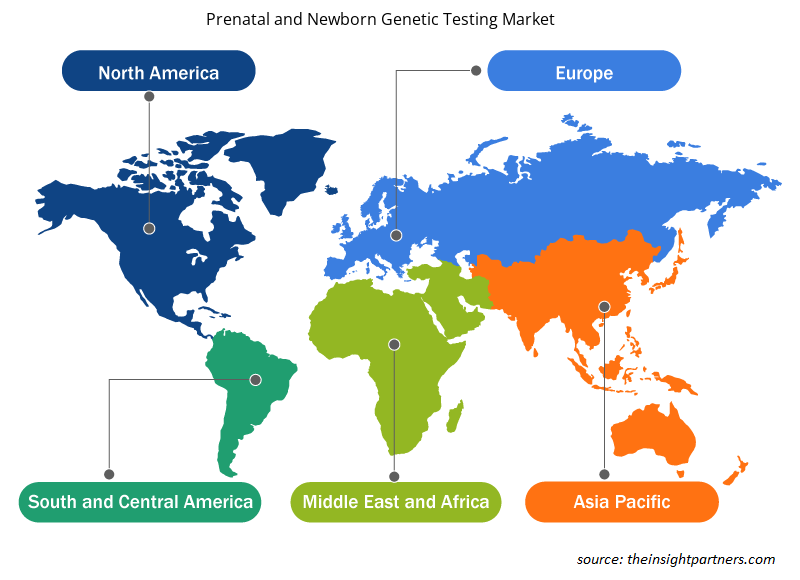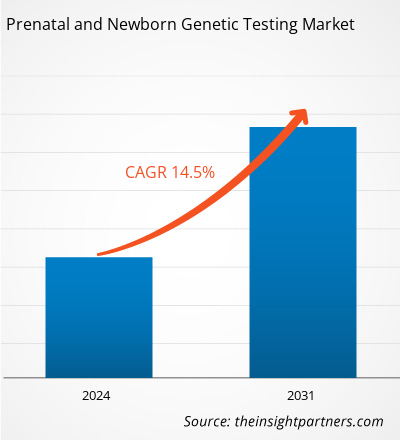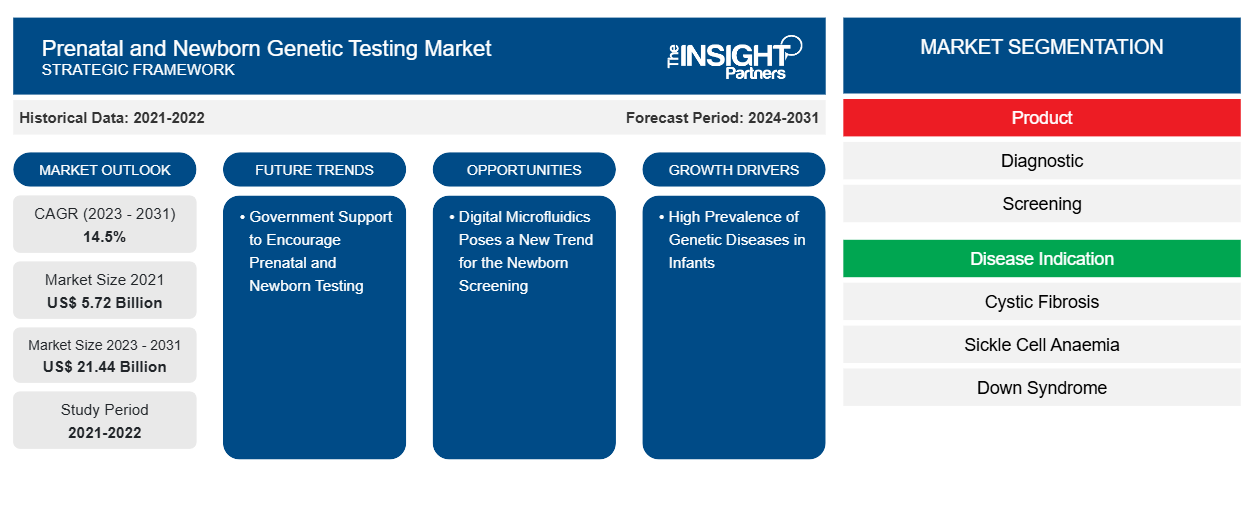La dimensione del mercato dei test genetici prenatali e neonatali nel 2021 era di 5,72 miliardi di dollari USA e si prevede che raggiungerà i 21,44 miliardi di dollari USA entro il 2031. Si prevede che il mercato registrerà un CAGR del 14,5% nel 2023-2031. È probabile che la microfluidica digitale per lo screening neonatale rimanga una delle principali tendenze del mercato dei test genetici prenatali e neonatali.CAGR of 14.5% in 2023–2031. Digital microfluidics for newborn screening is likely to remain key prenatal and newborn genetic testing market trends.
Analisi di mercato dei test genetici prenatali e neonatali
Lo sviluppo di capacità tecnologiche, la crescente accettazione e consapevolezza dei test genetici per lo screening prenatale e neonatale e una maggiore enfasi sull'assistenza sanitaria personalizzata sono alcuni fattori che stanno espandendo la crescita del mercato. Il futuro del mercato è plasmato dal ruolo cruciale che le soluzioni di test genetici svolgono nel migliorare la diagnosi precoce, il processo decisionale ben informato e i migliori risultati sanitari sia per le donne incinte che per i bambini. Si prevede che un numero crescente di aziende diagnostiche che operano nel dominio dello screening prenatale e neonatale , insieme a crescenti investimenti pubblici e privati, aumenteranno l'espansione del mercato durante il periodo di previsione.
Panoramica del mercato dei test genetici prenatali e neonatali
I test genetici prenatali vengono eseguiti durante la gravidanza per diagnosticare malattie o rilevare anomalie genetiche specifiche prima delle 8-10 settimane di gestazione. La maggior parte dei test genetici prenatali utilizza un campione di sangue della madre per la conduzione di vari screening. La crescente domanda di test genetici prenatali e neonatali per l'identificazione di anomalie genetiche, nonché la presenza di organizzazioni pubbliche e private-pubbliche come Genomic Health Inc. e il National Human Genome Research Institute, sta supportando la crescita del mercato. L'American Association for Clinical Chemistry (AACC) riconosce lo screening neonatale come un fattore critico per migliorare la salute dei bambini. Come sforzo verso la gestione delle malattie genetiche nei neonati, l'AACC sostiene gli sforzi pubblico-privati per mantenere, migliorare ed espandere i programmi di screening neonatale. Inoltre, l'aumento dell'età materna, che porta a complicazioni durante la gravidanza, sta alimentando la domanda di test genetici prenatali a livello globale.Genomic Health Inc. and the National Human Genome Research Institute, is supporting the growth of the market. The American Association for Clinical Chemistry (AACC) recognizes newborn screening as a critical factor for improving children’s health. As an effort toward the management of genetic diseases in infants, the AACC endorses public-private efforts to maintain, improve, and expand newborn screening programs. In addition, the increase in maternal age, leading to pregnancy complications, is fueling the demand for prenatal genetic testing globally.
Personalizza questo report in base alle tue esigenze
Riceverai la personalizzazione gratuita di qualsiasi report, comprese parti di questo report, o analisi a livello nazionale, pacchetto dati Excel, oltre a usufruire di grandi offerte e sconti per start-up e università
-
Scopri le principali tendenze di mercato in questo rapporto.Questo campione GRATUITO includerà analisi di dati che spaziano dalle tendenze di mercato alle stime e alle previsioni.
Driver e opportunità di mercato per i test genetici prenatali e neonatali
L'elevata prevalenza di malattie genetiche nei neonati guida la crescita del mercato
I feti nell'utero sono colpiti da varie malattie genetiche. Il modo in cui queste malattie genetiche vengono ereditate aiuta a determinare il rischio che comportano per la gravidanza e il rischio della sua recidiva. Il rischio di avere malattie genetiche nel neonato è alto in diversi casi, come quando i genitori hanno un altro figlio con una malattia genetica, una storia familiare di un disturbo genetico o se uno dei genitori ha un'anomalia cromosomica. C'è una sostanziale prevalenza di malattie genetiche tra i neonati e queste malattie sono anche responsabili della mortalità infantile a livello globale. La sindrome di Down è la forma più comune di disabilità intellettiva al mondo. Rimane la condizione cromosomica più comune diagnosticata negli Stati Uniti, che colpisce circa 1 bambino su 700. Secondo i dati dei Centers for Disease Control and Prevention (CDC), circa 6.000 bambini nati ogni anno negli Stati Uniti hanno la sindrome di Down. L'Organizzazione Mondiale della Sanità stima che 240.000 neonati in tutto il mondo muoiano ogni anno entro 28 giorni dalla nascita a causa di queste malattie. Altri 170.000 bambini muoiono tra 1 mese e 5 anni a causa di malattie congenite. Pertanto, la prevalenza di malattie genetiche tra i neonati aumenta la domanda di test genetici prenatali e neonatali, stimolando così la crescita del mercato.
Sostegno governativo per incoraggiare i test prenatali e neonatali per favorire la crescita del mercato
Con l'avanzare del campo della scienza genomica, i test genetici e genomici stanno diventando sempre più consueti in vari istituti clinici e sanitari. I governi e gli enti di regolamentazione sanitaria in tutto il mondo stanno comprendendo l'importanza dei test genetici e i benefici che questi test offrono. Per garantire la salute dei neonati, il governo in tutto il mondo adotta varie iniziative che richiedono ai bambini di sottoporsi a screening neonatale. Il programma California Newborn Screening (NBS) è un programma di sanità pubblica che sottopone tutti i neonati a screening per diversi disturbi genetici gravi ma curabili. Allo stesso modo, in India, il Dipartimento di biotecnologia ha lanciato l'iniziativa UMMID (The Unique Methods of Management and Treatment of Inherited Disorders) nel 2019. È progettata per promuovere lo screening genetico dei bambini nella nazione. Pertanto, si prevede che l'aumento del sostegno da parte del governo per promuovere l'uso di test prenatali e nuovi test genetici in tutto il mondo contribuirà alla crescita del mercato in futuro.
Analisi della segmentazione del rapporto di mercato sui test genetici prenatali e neonatali
I segmenti chiave che hanno contribuito alla derivazione dell'analisi di mercato dei test genetici prenatali e neonatali sono il prodotto, l'indicazione della malattia e l'utente finale.
- In base al prodotto, il mercato dei test genetici prenatali e neonatali è diviso in diagnostico e screening. Il segmento dello screening ha detenuto la quota di mercato maggiore nel 2023 e si prevede che registrerà il CAGR più elevato durante il periodo di previsione.
- In base all'indicazione della malattia, il mercato è segmentato in fibrosi cistica, anemia falciforme, sindrome di Down, fenilchetonuria e altre malattie. Il segmento della sindrome di Down ha detenuto la quota maggiore del mercato nel 2023. Inoltre, si prevede che il segmento della fibrosi cistica registrerà il CAGR più elevato durante il periodo di previsione.
- In base all'utente finale, il mercato dei test genetici prenatali e neonatali è suddiviso in ospedali e cliniche, centri diagnostici e altri utenti finali. Il segmento ospedali e cliniche ha detenuto la quota di mercato maggiore nel 2023. Inoltre, si prevede che il segmento centri diagnostici registrerà il CAGR più elevato durante il periodo di previsione.
Analisi della quota di mercato dei test genetici prenatali e neonatali per area geografica
L'ambito geografico del rapporto sul mercato dei test genetici prenatali e neonatali è suddiviso principalmente in cinque regioni: Nord America, Asia Pacifico, Europa, Medio Oriente e Africa, Sud e Centro America.
Il Nord America ha dominato il mercato dei test genetici prenatali e neonatali. Il mercato del Nord America si sta espandendo a causa di una serie di fattori, tra cui l'aumento della prevalenza di malattie genetiche tra i neonati, iniziative governative di supporto e iniziative intraprese da varie organizzazioni per facilitare l'uso dei test prenatali e neonatali e l'aumento del tasso di natalità. Secondo il CDC, i difetti alla nascita colpiscono uno su 33 bambini nati ogni anno negli Stati Uniti. Inoltre, si prevede che la domanda per il mercato nella regione crescerà in modo significativo durante il periodo di previsione a causa degli obblighi normativi per l'esecuzione di test prenatali e neonatali, della crescente attenzione all'integrazione di metodi avanzati nell'assistenza sanitaria e del lancio di test non invasivi per la diagnosi di test prenatali e genetici nella regione. Si prevede che l'Asia Pacifica crescerà con il CAGR più elevato nei prossimi anni.
Approfondimenti regionali sul mercato dei test genetici prenatali e neonatali
Le tendenze regionali e i fattori che influenzano il mercato dei test genetici prenatali e neonatali durante il periodo di previsione sono stati ampiamente spiegati dagli analisti di Insight Partners. Questa sezione discute anche i segmenti e la geografia del mercato dei test genetici prenatali e neonatali in Nord America, Europa, Asia Pacifico, Medio Oriente e Africa e Sud e Centro America.

- Ottieni i dati specifici regionali per il mercato dei test genetici prenatali e neonatali
Ambito del rapporto di mercato sui test genetici prenatali e neonatali
| Attributo del report | Dettagli |
|---|---|
| Dimensioni del mercato nel 2021 | 5,72 miliardi di dollari USA |
| Dimensioni del mercato entro il 2031 | 21,44 miliardi di dollari USA |
| CAGR globale (2023-2031) | 14,5% |
| Dati storici | 2021-2022 |
| Periodo di previsione | 2024-2031 |
| Segmenti coperti |
Per Prodotto
|
| Regioni e Paesi coperti |
America del Nord
|
| Leader di mercato e profili aziendali chiave |
|
Densità degli attori del mercato dei test genetici prenatali e neonatali: comprendere il suo impatto sulle dinamiche aziendali
Il mercato dei test genetici prenatali e neonatali sta crescendo rapidamente, spinto dalla crescente domanda degli utenti finali dovuta a fattori quali l'evoluzione delle preferenze dei consumatori, i progressi tecnologici e una maggiore consapevolezza dei benefici del prodotto. Con l'aumento della domanda, le aziende stanno ampliando le loro offerte, innovando per soddisfare le esigenze dei consumatori e capitalizzando sulle tendenze emergenti, il che alimenta ulteriormente la crescita del mercato.
La densità degli operatori di mercato si riferisce alla distribuzione di aziende o società che operano in un particolare mercato o settore. Indica quanti concorrenti (operatori di mercato) sono presenti in un dato spazio di mercato in relazione alle sue dimensioni o al valore di mercato totale.
Le principali aziende che operano nel mercato dei test genetici prenatali e neonatali sono:
- Abate
- Quest Diagnostics Inc.
- Laboratori Bio-Rad, Inc.
- Illumina, Inc.
- Società anonima F. Hoffmann La-Roche Ltd.
- Qiagen
Disclaimer : le aziende elencate sopra non sono classificate secondo un ordine particolare.

- Ottieni una panoramica dei principali attori del mercato dei test genetici prenatali e neonatali
Notizie di mercato e sviluppi recenti sui test genetici prenatali e neonatali
Il mercato dei test genetici prenatali e neonatali viene valutato raccogliendo dati qualitativi e quantitativi post-ricerca primaria e secondaria, che includono importanti pubblicazioni aziendali, dati associativi e database. Di seguito è riportato un elenco degli sviluppi nel mercato dei test genetici prenatali e neonatali e delle relative strategie:
- PerkinElmer Inc. ha ricevuto l'autorizzazione della Food and Drug Administration statunitense per la commercializzazione del kit di analisi EONIS SCID-SMA per uso diagnostico in vitro (IVD) da parte di laboratori certificati per la rilevazione simultanea di atrofia muscolare spinale (SMA) e immunodeficienza combinata grave (SCID) nei neonati. Questo è il primo test autorizzato dalla FDA per lo screening SMA nei neonati negli Stati Uniti e fa parte della più ampia piattaforma EONIS dell'azienda. (Fonte: PerkinElmer Inc., comunicato stampa, 2022)
- LifeCell International ha lanciato 'Genome-Scope', un test diagnostico genetico di prim'ordine per neonati che valuta migliaia di disturbi che insorgono nella prima infanzia. (Fonte: LifeCell International Private Limited, comunicato stampa, 2020)
Copertura e risultati del rapporto sul mercato dei test genetici prenatali e neonatali
Il rapporto "Dimensioni e previsioni del mercato dei test genetici prenatali e neonatali (2021-2031)" fornisce un'analisi dettagliata del mercato che copre le seguenti aree:
- Dimensioni del mercato e previsioni a livello globale, regionale e nazionale per tutti i principali segmenti di mercato interessati dall'indagine.
- Dinamiche di mercato come fattori trainanti, vincoli e opportunità chiave
- Principali tendenze future
- Analisi dettagliata delle cinque forze PEST/Porter e SWOT
- Analisi di mercato globale e regionale che copre le principali tendenze di mercato, i principali attori, le normative e gli sviluppi recenti del mercato
- Analisi del panorama industriale e della concorrenza che copre la concentrazione del mercato, l'analisi della mappa di calore, i principali attori e gli sviluppi recenti
- Profili aziendali dettagliati
- Analisi storica (2 anni), anno base, previsione (7 anni) con CAGR
- Analisi PEST e SWOT
- Valore/volume delle dimensioni del mercato - Globale, Regionale, Nazionale
- Industria e panorama competitivo
- Set di dati Excel
Report recenti
Rapporti correlati
Testimonianze
Motivo dell'acquisto
- Processo decisionale informato
- Comprensione delle dinamiche di mercato
- Analisi competitiva
- Analisi dei clienti
- Previsioni di mercato
- Mitigazione del rischio
- Pianificazione strategica
- Giustificazione degli investimenti
- Identificazione dei mercati emergenti
- Miglioramento delle strategie di marketing
- Aumento dell'efficienza operativa
- Allineamento alle tendenze normative























 Ottieni un campione gratuito per - Mercato dei test genetici prenatali e neonatali
Ottieni un campione gratuito per - Mercato dei test genetici prenatali e neonatali